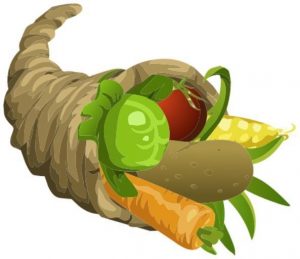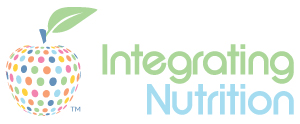LisaTheRD’s Survival Guide for the Thanksgiving Holiday
Part 1: Let’s get ready for the big Turkey meal!
 Thanksgiving brings to mind a whole host of things: enduring and ongoing traditions, gatherings of friends and family, football on TV, often crazy traffic (it’s the most traveled holiday in these United States, after all) and—of course—the turkey and the food.
Thanksgiving brings to mind a whole host of things: enduring and ongoing traditions, gatherings of friends and family, football on TV, often crazy traffic (it’s the most traveled holiday in these United States, after all) and—of course—the turkey and the food.
Especially food.
Lots of food. Not for nothing, the holiday is often nicknamed “Turkey Day.” And everyone faces this national, seasonal feast in his or her own, personal and unique way.
Some of us regard the holiday meal as if it were an “All You Can Eat Challenge” extravaganza.
Others mechanically pile their plates with gobs of everything set before them, and then feel obligated to eat all they took.
Still others allow the eating and food issues they struggle with the rest of the year to spin wildly out of control on Thanksgiving: they stuff themselves with food in response to disappointments and frustrated expectations stemming from things like the aforementioned traditions, friends and family, football, and crazy traffic.
In my practice as a Registered Dietitian and Nutrition Therapist, I have worked with quite a few clients who view the holidays with more than a bit of trepidation. Even outside of the consultation room, friends confess to me that they regard Thanksgiving dinner—and the many festive meals and parties in the holiday season that follows Thanksgiving—with a kind of grim resignation, having made peace with the likelihood that they will end up eating and drinking more than they’d like, and then dearly regretting it later.
There’s an expression you hear quite a bit these days: “If you fail to plan, you plan to fail,” and that sentiment pretty well captures my advice about food and the holiday. If we commit to not stuff ourselves, and then approach “Turkey Day” with clear, articulated food consumption strategies in mind, we stand a better chance of having a Thanksgiving experience that’s satisfying for both body and soul.
PREPARING FOR THE THANKSGIVING MEAL
Our first strategy revolves around pre-meal food choices. Thanksgiving tends to be chock full of what we think of as comfort food: mounds of mashed potatoes, candied yams, cranberry sauces, savory stuffings, pumpkin pies, thick gravies, and, well, you get the picture. Lots of carbs, lots of calories, lots of fats. Obviously, if you are planning the meal, you have the opportunity to prepare a menu that skews to the healthy side.
For instance, instead of cooking a whole turkey, consider preparing one or two full sized turkey breasts. Turkey breasts contain white meat and are lower in fat. Since white meat cooks at a lower temperature than dark meat anyway, with roasted turkey breasts your meat course can be slow-roasted to moist and juicy perfection (as opposed to a full cooked turkey that yields dry white meat and moist dark meat,) and a ton of delicious turkey breast recipes are just a Google search away. Likewise, select starch course recipes that call for less sugar—yams are plenty sweet on their own—and utilize more whole grains for stuffing, like brown or wild rice, or savory quinoa. Incorporating high fiber vegetables and grains will satisfy your appetite in a tasty, healthful way.
If you are a guest at someone else’s table (and so have no control over what is to be served,) ask if you may bring a healthy, generously stocked serving dish of your own. Not only can you share your dish with your fellow diners, you can be sure that you have at least one healthy item to build your meal around. For instance, a hearty raw veggie salad with a light vinaigrette dressing, sprinkled with toasted pumpkin seeds (perhaps harvested from your Halloween jack o’ lantern pumpkins) would be seasonably appropriate. Then you can add to your own plate small tasting servings from the rest of the table.
THE DAY OF THE THANKSGIVING MEAL
I always recommend that on Thanksgiving Day my clients have the kinds of breakfasts and lunches they would normally eat on any other day, and not abstain from eating “to make room for” the big meal. If we sit down to the table super-hungry, we tend to eat ravenously and quickly, stuffing in more food than we need to before our bodies have the chance to signal that we are full. Slow, mindful eating is a critical must here…it actually takes about 20 minutes for the brain to get the “stop eating, tummy is full” signal from the stomach. A tip I often share: One way to slow your eating is to chew each bite well, savoring the flavor and putting the fork down onto the table between bites.
Moreover, the very idea of eating until full is actually problematic. It is much healthier, all evidence suggests, to eat to the point of feeling “not hungry” instead of achieving complete fullness. And if you finish your meal groaning and loosening your belt… well, you’ve eaten way too much!
Other “Don’t Stuff Yourself” strategies have to do with your own attitude and behavior. Before the meal you might remind yourself of the times in the past you’ve over-eaten and felt uncomfortable, and conversely think about times you had not over-eaten and felt grateful about that choice. Commit to the same positive results for the meal you are about to have.
Gratitude, of course, plays a big part of thanksgiving, and can be part of your “Don’t Stuff Yourself” strategy. Decide to keep your focus on the event—more on why you are celebrating the holiday, and less on the food. Try listing at least three things you’re thankful for before you even take a seat at the table.
And then, when you take a seat at the table… well, check this blog next week for my “T-Day” recommendations on good strategies one might take when the meal actually starts!





